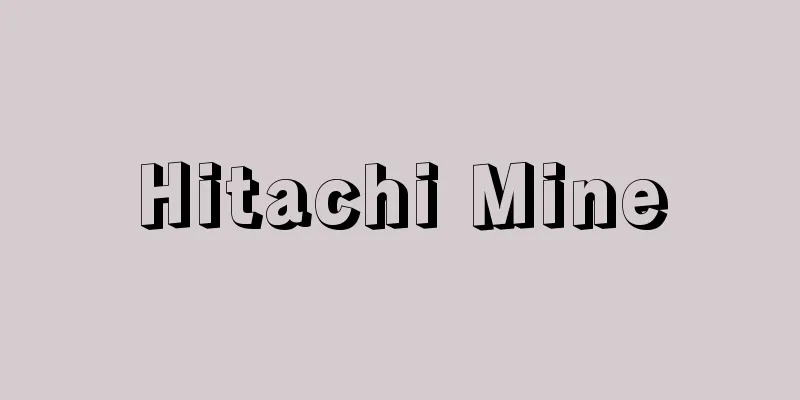Hitachi Mine

|
This copper mine was located in Hitachi City, northeastern Ibaraki Prefecture. Gold, silver, copper, zinc, etc. were extracted from copper-bearing iron sulfide deposits in metamorphic rocks in the Taga Mountains. The area south of Mount Kamine has long been called Mount Akazawa, and has produced gold, silver, and copper since the time of the Satake clan. Copper ore was also mined during the Edo period, and there are records of damage from bad water (pollution). In 1862 (Bunkyu 2), the mine produced 2,000 kan of copper ore, but in 1864 (Genji 1), the facilities were burned down during party strife within the Mito domain. The management changed hands several times after that, but in 1905 (Meiji 38), Kuhara Fusanosuke began operations as the Hitachi Mine of the Kuhara Mining Company. The mine integrated the entire process from mining to smelting and electrosmelting, and developed into a modern diversified business with hydroelectric power plants, electric railways, and other facilities. It also prevented smoke pollution with a large chimney (155.7 meters high) and produced by-products by establishing a sulfuric acid plant. The electric appliance manufacturer Hitachi was also separated and became independent, becoming the source of Hitachi City's modern mining and manufacturing development. The valley of the Miyata River was occupied by factories and mining villages, and its prosperity extended across the watershed to the Sato River valley. In 1965 (Showa 40), including some small mines, the production value was 151 kilograms of gold ore, 1,443 kilograms of silver ore, 6,120 tons of copper ore, and 230,000 tons of sulfide ore. However, due to trade liberalization and the depletion of copper resources, smelting was discontinued in 1976 and closed in 1981. Only a small electrosmelting plant remains. In 1985, the Nippon Mining Memorial Hall was built on the site of the mine. [Akitoshi Sakurai] Hitachi Village, Taga County, Ibaraki Prefecture (present-day Miyata Town, Hitachi City). Photo Collection of Scenic Places and Historic Sites of Japan, Kanto Region (1918, Taisho 7), National Diet Library Hitachi Mine (Taisho era) Source: Shogakukan Encyclopedia Nipponica About Encyclopedia Nipponica Information | Legend |
|
茨城県北東部、日立市にあった銅山。多賀(たが)山地の変成岩中の含銅硫化鉄鉱床より金、銀、銅、亜鉛などを採掘した。神峰(かみね)山の南側一帯は古くから赤沢(あかさわ)山とよばれ、佐竹氏時代より金、銀、銅を産した。江戸時代にも銅鉱が採掘され、悪水被害(公害)の記録もある。1862年(文久2)銅鉱2000貫を産したが、1864年(元治1)水戸藩内の党争にあって施設は焼失した。その後も経営者は変遷したが1905年(明治38)に久原房之助(くはらふさのすけ)が久原鉱業所日立鉱山として操業を開始した。採掘から製錬、電錬までの工程を一貫化し、水力発電所、電車鉄道など近代的多角経営によって発展、さらに大煙突(高さ155.7メートル)で煙害を防止し、硫酸工場設置による副産物製造も行った。ほかに電機メーカー日立製作所が分離、独立するなど日立市の近代鉱工業発展の源泉となった。宮田川の谷は工場と鉱山集落で占められ、分水嶺(ぶんすいれい)を越えて里(さと)川の谷まで繁栄を及ぼした。1965年(昭和40)の生産額は一部の小鉱山も含めて金鉱151キログラム、銀鉱1443キログラム、銅鉱6120トン、硫化鉱23万トンを産した。しかし、貿易の自由化、銅資源の枯渇によって1976年から製錬をやめ、1981年に閉山。わずかに電錬工場を残している。1985年、鉱山跡地に日鉱記念館が建てられた。 [櫻井明俊] 茨城県多賀郡日立村(現在の日立市宮田町)。『日本名勝旧蹟産業写真集 関東地方之部』(1918年〈大正7〉)国立国会図書館所蔵"> 日立鉱山(大正時代) 出典 小学館 日本大百科全書(ニッポニカ)日本大百科全書(ニッポニカ)について 情報 | 凡例 |
>>: Hitachiota [city] - Hitachiota
Recommend
Karsavina, Tamara Platonovna
Born: March 9, 1885/March 10, 1885, St. Petersburg...
Anti-trust laws
Also known as the Antitrust Act, this refers to th...
Buddleia curviflora (English spelling)
…[Mr. Makoto Fukuoka]. … *Some of the terminology...
Mahavairocana (English spelling)
…He lived in the Lotus Treasury World and became ...
Study book - Study book
[1] [noun] A book or document on music. ※Shiji Sho...
Ophthalmoplegic headache - ophthalmoplegic headache
...Severe pain occurs in the forehead, cheeks, an...
Pinturicchio
Italian painter. His real name was Bernardino di B...
Itakiso Shrine
Located in Itakiso, Wakayama City. Formerly a Kanp...
Lexington
A town in the Shenandoah Valley in western Virgini...
Nishikore [town] - Seihi
An old town in the northeastern part of the Nishis...
Misunderstanding
〘 noun 〙 To misinterpret what the other person has...
Daumesdick
…On the way back to his parents after receiving t...
Ikenobo Senjo - Ikenobo Senjo
1769-1832 A flower arranger from the late Edo per...
Lagos (Dynasty) (English spelling) Lagos
...305 or 304 BC - 30 BC. The dynasty was called ...
Yoshida Harufu
Shakuhachi performer and composer. His real name ...









